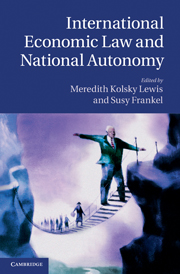Book contents
- Frontmatter
- Contents
- Notes on contributors
- Acknowledgements
- Introduction
- PART I International economic law: conceptions of convergence and divergence
- PART II WTO treaty interpretation: implications and consequences
- PART III Responding to international economic law commitments
- PART IV Transformations in international economic law
- 11 Foreign investors vs sovereign states: towards a global framework, BIT by BIT
- 12 How ‘trade in services’ transforms the regulation of temporary migration for remittances in poor countries
- 13 Reconceptualising international investment law: bringing the public interest into private business
- Index
- References
13 - Reconceptualising international investment law: bringing the public interest into private business
from PART IV - Transformations in international economic law
Published online by Cambridge University Press: 10 January 2011
- Frontmatter
- Contents
- Notes on contributors
- Acknowledgements
- Introduction
- PART I International economic law: conceptions of convergence and divergence
- PART II WTO treaty interpretation: implications and consequences
- PART III Responding to international economic law commitments
- PART IV Transformations in international economic law
- 11 Foreign investors vs sovereign states: towards a global framework, BIT by BIT
- 12 How ‘trade in services’ transforms the regulation of temporary migration for remittances in poor countries
- 13 Reconceptualising international investment law: bringing the public interest into private business
- Index
- References
Summary
Introduction
Recent investor-state arbitration has heightened awareness of public interest issues in international investment disputes and illustrated its capacity to constrain the regulatory autonomy of host states. Procedurally, these disputes employ the model of international commercial arbitration, which emphasises confidentiality, closed proceedings and commercial considerations. This model is largely uncontroversial when applied to an international commercial dispute between private parties. However, investor-state arbitration is a different creature. Matters of public interest are inherently involved in investor-state disputes. And yet, the current arbitration model is ill-equipped to address these wider issues. This is most evident where public service sectors are implicated or where domestic regulation enacted for public welfare purposes is the subject of complaint. Although these cases resolve questions that can affect significant matters of public policy, the public generally does not have access to the documents, the proceedings are conducted behind closed doors, and the submission of amicus curiae briefs is restricted, if permitted at all.
In addition to the procedural issues, investor-state arbitration has also highlighted an imbalance in the substantive principles of international investment law. There is little room for the consideration of the public interest in a regime so heavily weighted towards investor protection. Therefore, there is a need for more balanced international investment agreements that retain strong investor protection but impose corresponding levels of investor responsibility. There is also a need for greater engagement with principles from other areas of international law.
- Type
- Chapter
- Information
- International Economic Law and National Autonomy , pp. 295 - 319Publisher: Cambridge University PressPrint publication year: 2010
References
- 4
- Cited by



